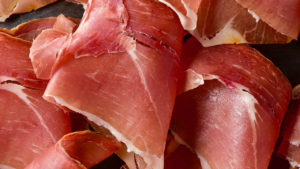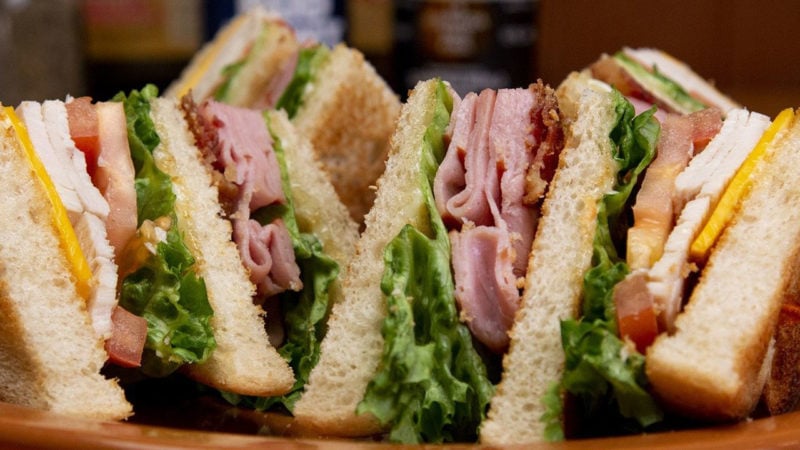Last Updated on November 26, 2024
When it comes to crafting the perfect sandwich or assembling a charcuterie board, different types of lunch meats take center stage. These versatile and flavorful slices of cured and cooked meats are a staple in many cuisines around the world. In this blog, we’ll take a detailed look at many of the different types of lunch meats and what they’re best used for.
Varieties of Lunch Meat
Lunch meat, also known as deli meat or cold cuts, comes in various types, each made from different kinds of meats and processed in various ways. Many have added ingredients, spices, sea salt from curing, and even added sugar and flavorings sometimes.

Thinly sliced ham is hard to beat – this prosciutto is a delicious cured pork that can be eaten plain or in a recipe.
Ham
1 – Ham: Ham is a classic lunch meat and perhaps the most popular lunch meat. It is made from cured and often smoked pork. Varieties of sliced ham include honey ham, black forest uncured ham, and Virginia ham.
2 – Salami: Salami is a type of dry-cured sausage, and it’s often sliced thin for sandwiches. Common types of hard salami include Genoa salami, pepperoni, cotto salami, and soppressata.
3 – Prosciutto: Prosciutto is a dry-cured ham that’s thinly sliced and often served in Italian dishes or on charcuterie boards.
4 – Capicola: Capocollo or coppa, is a type of Italian cold cut made from pork shoulder or neck. It’s a boiled ham that is dry-cured and sliced very thinly.
5 – Pancetta: Pancetta is Italian bacon made from pork belly and used in a variety of dishes, including sandwiches and salads.
6 – Soppressata: Soppressata is a type of Italian dry salami that’s often spicy and made from pork.
7 – Serrano Ham: A serrano ham is a Spanish ham that is world famous for its dry texture and rich, salty flavor. It is aged usually for over a year.
8 – Mortadella: Mortadella is an Italian bologna-like cold cut made with finely ground pork and typically contains pieces of fat and other spices like whole garlic cloves.
Turkey
9 – Turkey breast: Thinly sliced turkey breast is a popular choice for sandwiches. It’s available in various flavors, including smoked and oven-roasted. Sliced roasted or smoked turkey breast is a popular choice for sandwiches.
10 – Peppered Turkey: Sliced turkey breast coated with black peppercorn or crushed black pepper for added flavor.

Thinly slicing roast beef and beef brisket.
Beef
11 – Roast Beef: This lunch meat is typically made from thinly sliced, slow-roasted beef. It can range from rare to well-done in terms of doneness.
12 – Pastrami: Beef pastrami is made from beef brisket and is known for its strong flavor and seasoning. It is brined and then cured. And it’s typically served hot on sandwiches, such as a Reuben.
13 – Corned Beef: Corned beef is made from beef brisket that has been brined with spices. It’s commonly used in sandwiches like corned beef and cabbage or the classic Reuben.
14 – London Broil: The name refers to a top round or flat slab of beef that is broiled at high heat. Sliced and seasoned, it makes for a corned beef alternative with a meaty flavor.
15 – Beef Salami: Similar to the traditional pork salami, except made from a red meat beef base.
Chicken
16 – Chicken Breast: Chicken lunch meat is often made from sliced or shredded whole chicken breast filets. It can be seasoned or flavored differently to suit different tastes. Chicken meat or other poultry deli meat is a healthy option when choosing lean protein.
17 – Rotisserie-Style Chicken: When a chicken is cooked in a rotisserie or roaster, the end result can be a more juicy and flavorful chicken. Some places will then thinly slice the fresh chicken rotisserie meat for cold cuts.

Sliced smoked sausage and other ground porks can make great charcuterie meat options.
Bologna & Wursts
18 – Bologna: Bologna, also spelled baloney, is a processed meat product made from ground pork, beef, or a combination of meats. It’s often sliced and used in sandwiches.
19 – Pepperoni: Usually made from a combination of pork, beef, and spices, pepperoni is a cased meat that can be sliced and put on Italian-style sandwiches.
20 – Pimento Loaf: Pimento loaf is a processed lunch meat made from ground pork or beef, seasoned, and typically containing bits of pimento pepper.
21 – Liverwurst: Liverwurst is a type of liver sausage made from pork or beef liver. It has a rich and creamy texture when in a spread form. But it can also be sliced and used as a deli meat.
22 – Head Cheese: Head cheese is a cold cut made from the head meat of a pig or calf and is often set in aspic.
23 – Assorted Loaves: Olive terrine, pickle, pimento, and other pepper loaves are often combined with bologna as a base to create a spicy and flavorful slice.

Smoked salmon is an omega-rich deli meat alternative option.
Others
24 – Tongue: Beef or pork tongue is sometimes used as a deli meat, usually thinly sliced.
25 – Duck Breast: Smoked or cured duck breast is a gourmet option for sandwiches or charcuterie. It is definitely a higher (healthy) fat option, great for an appetizer or smaller recipe.
26 – Tuna Salad: Tuna salad is made by mixing canned tuna with mayonnaise and other ingredients. It’s a popular filling for sandwiches and wraps. While not a sliced deli meat, it falls under the lunch protein category and is a great lean meat option.
27 – Egg Salad: Egg salad is made by mashing hard-boiled eggs and mixing them with mayonnaise and seasonings. It’s a creamy and satisfying lunch option.
28 – Turkey Bacon: Turkey bacon is a leaner alternative to traditional pork bacon. It’s often used in sandwiches, burgers, and wraps.
29 – Smoked Salmon: Smoked salmon, also known as lox, is a cold-smoked fish that’s often served on bagels with cream cheese.
30 – Tofurky: Tofurky is a vegan or vegetarian lunch meat alternative made from tofu. It’s designed to mimic the texture and flavor of traditional lunch meats.
These are some of the common types of lunch meats, but there are many regional and specialty variations available, each with its own unique flavor and texture..
Creative Ways to Enjoy Lunch Meat
While deli sandwiches are the go-to for lunch meat, there are countless creative ways to incorporate these tasty slices into your meals:
- Wrap it Up: Swap out tortillas with your favorite packed deli meat for a low-carb alternative to wraps.
- Roll-Ups: Lay lunch meat flat and spread it with cream cheese or a tasty spread for extra flavor, then roll it up for a bite-sized snack.
- Charcuterie Boards: Create a stunning charcuterie board with an assortment of lunch meats, cheeses, veggies, fruits, hummus, and crackers.
- Salads: Add sliced turkey, ham, or chicken to your salads for an extra protein boost.
- Egg Salad: Elevate your egg salad and use up any leftover sandwich meats by mixing in some diced ham or turkey for added flavor and texture.
- Stuffed Peppers: Fill bell peppers with a mixture of rice, vegetables, and diced lunch meat for a satisfying entrée.
What is the healthiest lunch meat?
While lunch meats are delicious and convenient, it’s essential to be mindful of some health considerations. A lot of people may be wondering what is the healthiest lunch meat. The answer is that there are lots of healthy choices when it comes to cold meats – as long as you keep processed meat consumption at a minimum, pay attention to fat content, and buy as fresh meat as possible.
So, the next time you’re shopping at your local grocery store, think about these things:
Sodium Content: Many lunch meats are high in sodium, which can be a concern for those with high blood pressure. Look for lower-sodium options.
Processed Meats: Some lunch meats are heavily processed and may contain common additives, like added nitrates. Consider choosing minimally processed options when available. The sliced meat with the least amount of additives is usually the healthier option.
Allergies: Be aware of any allergies or dietary restrictions when selecting lunch meats. Make sure to read the nutrition label and ingredient list for any preservatives or added ingredients that may not be a good choice for certain people with health conditions.
How to Store Lunch Meat
Lastly, it’s important to know how to properly store lunch meat for maximum shelf life. After opening sealed pre-sliced lunch meat, it’s important to keep it refrigerated (40 degrees or less) and consume it within 3-5 days.
Make sure lunch meat is in a sealed container so it doesn’t lose moisture. This will cause the meat to dry out and not be enjoyable for as long as it could be.
So, whether you’re enjoying a classic turkey and Swiss sandwich or exploring gourmet prosciutto on a charcuterie board, lunch meat is a versatile and beloved meat choice by many. For more tips and recipes, check out JustCook blog.


